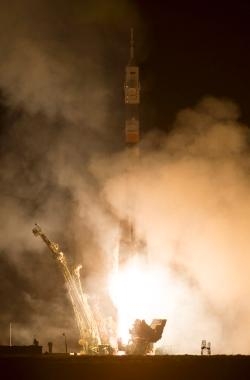Two Russians, One American Comprise The New Crew
Three crew members representing the United States and Russia are on their way to the International Space Station after launching from the Baikonur Cosmodrome in Kazakhstan at 1717 EDT Tuesday. The Soyuz capsule carrying Steve Swanson of NASA and Soyuz Commander Alexander Skvortsov and Oleg Artemyev of the Russian Federal Space Agency (Roscosmos) docked with the space station about six hours after launch.

The arrival of Swanson, Skvortsov and Artemyev returns the station's crew complement to six. The three will join Expedition 39 Commander Koichi Wakata of the Japan Aerospace Exploration Agency -- the first Japanese astronaut to command the space station -- Rick Mastracchio of NASA and Mikhail Tyurin of Roscosmos. They have been aboard the complex since November 2013.
The crew members will conduct hundreds of scientific investigations and technology demonstrations during their six-month sojourn on the orbiting laboratory. These include looking at how the microgravity environment affects the body's ability to fight infection; trying to grow healthy, tasty produce in space; and testing a new laser communications package.
One experiment, called T-Cell Activation in Aging, studies depression of the human immune system in microgravity. T-cells, which are a type of white cell, are coated with chemical receptors that must trigger together to activate the body's immune system properly. T-cells from spaceflight crews and ground volunteers in a range of ages will be analyzed.
The Veggie hardware validation test will evaluate a new plant growth system that might make it feasible to eat plants grown on the space station. Veggie provides lighting and nutrient delivery for efficient plant growth in space. The plants grown in Veggie can support a wide range of uses, from research and education outreach, to a fresh food source and recreational gardening activities for long duration space missions, which eventually will include missions to an asteroid and Mars.
Optical Payload for Lasercomm Science (OPALS) will test the potential for using a laser to transmit data to Earth from space. Instead of being broadcast on radio waves, data is packaged onto beams of laser light and pointed to a receiver station on the ground. Radio wave transmissions are limited by the speed they can transfer data, but beaming information packages with lasers can greatly increase the amount of information transmitted over the same period of time.
The Soyuz also is carrying hardware for the Microbiome investigation, which will continue studies on the impact of space travel on the immune system and on human microbiomes, the scientific name for the many different microbes living in and on the human body at any given time. Like the previous expeditions, samples from crew members’ bodies and the space station environment will be taken periodically to monitor changes in the immune system and microbiomes. The results of this study may add to research on health impacts to people who live and work in extreme environments on Earth and help with research on early disease detection, metabolic function and immune system deficiency.
The Expedition 39 crew will perform additional experiments that cover human research, biological and physical sciences, technology development and Earth observations, as well as engage in educational activities. The crew will conduct a pair of Russian spacewalks and as many as three U.S. spacewalks. They will greet two Russian Progress spacecraft resupply flights, the final European ATV cargo spacecraft, the second commercial resupply flight of Orbital Science's Cygnus spacecraft, and the third and fourth flights of SpaceX's Dragon cargo spacecraft.
The International Space Station is a convergence of science, technology and human innovation that demonstrates new technologies and makes research breakthroughs not possible on Earth. The space station has had continuous human occupation since November 2000. In that time, it has received more than 200 visitors and a variety of international and commercial spacecraft. The space station remains the springboard to NASA's next great leap in exploration.
(Image provided by NASA)
 Airborne-Flight Training 05.09.24: ERAU at AIAA, LIFT Diamond Buy, Epic A&P
Airborne-Flight Training 05.09.24: ERAU at AIAA, LIFT Diamond Buy, Epic A&P ANN's Daily Aero-Term (05.07.24): Hazardous Weather Information
ANN's Daily Aero-Term (05.07.24): Hazardous Weather Information Aero-News: Quote of the Day (05.07.24)
Aero-News: Quote of the Day (05.07.24) NTSB Final Report: Cessna 150
NTSB Final Report: Cessna 150 Aero-News: Quote of the Day (05.08.24)
Aero-News: Quote of the Day (05.08.24)



